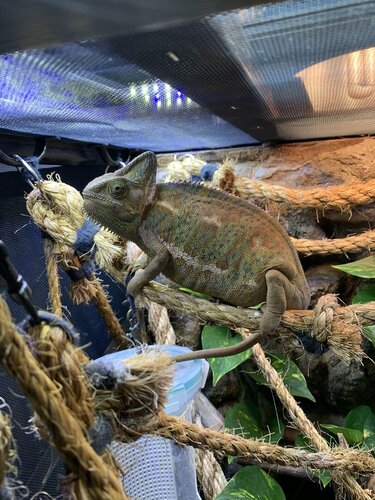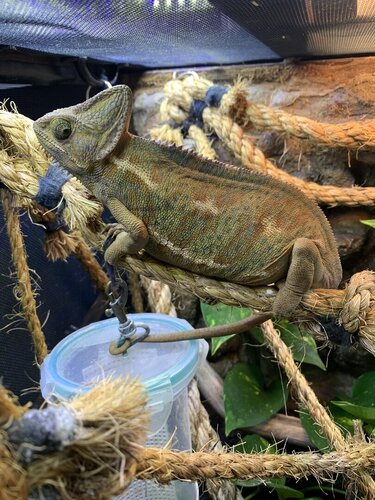FathomsBelow
New Member
Hello,
About a week ago, our 15-month-old chameleon, June, started showing signs of laying eggs. She would dig test holes, and spend long days on the ground, that sort of thing.
About 3 days in June meticulously dug and reburied a hole overnight before returning to basking. After not going down to the floor for a day, I investigated and unearthed a clutch of 36 eggs.
About a day after I retrieved the eggs, she decided to climb down to the bottom again to dig a little more. This time spending roughly 6 hours down at the bottom. At this point, she dug a few more holes and stopped.
I would say we are about 8-10 days since she started this process and she continues to venture to the bottom, she revisits a hole that was dug a few days ago, makes no further progress, doesn't cover it up, and climbs back up.
The time spent below seems to be getting shorter, spending roughly 3.5 hours down today.
In all of our research, we have not found similar examples of this behavior, and we would otherwise be worried but she continues to have a very healthy appetite, eating, drinking and acting like normal.
She does show increased thirst but will quickly refuse water when she's had enough. Her eyes, veil, color, and personality all seem happy and healthy. Just today she has even started trying to climb onto us again when we open her cage door. Absolutely no difference except for the visits to the bottom.
Some info on her enclosure:
Dimensions 4.5 ft tall, 2 ft wide, 2 ft deep with screened walls and top.
It is a bioactive cage with living plants.
The bottom 12" is a lightly planted substrate designed for her to burrow in, even has fake tree roots which is where I found the clutch.
Originally the substrate was peat moss, topsoil, and bark. However, I changed half the cage to a topsoil sand mix when she continued to dig. My fear was her tunnels were caving in.
We fully cover her cage and avoid the room as much as possible when she goes down to avoid spooking her.
We have two plant lights, a basking light and a UVB bulb. Her cage gets to a max temp for 84f, but usually hangs around 80f.
Her lights run from 7 in the morning to 6 at night. We try to match the outside light cycle as close as possible.
There is an automated mister in the cage which collects water droplets on all leaves throughout the day. She will also drink from a handheld mister bottle as we water her cage during feeding.
All water is dechlorinated.
Her diet every day consists of 6/8 medium-sized gut-loaded crickets or 4 super worms in the morning. At night she gets a few small pieces of greens, and a small very thin sliver of apple.
She receives calcium with NO D3 5 days a week, on the 6th day we rotate every other week with reptivite or calcium WITH D3. On the 7th day she receives no supplements.
I'd be more than happy to provide any other information.
My wife and I are kinda at a loss, is this a sign of something very wrong or possibly a more normal behavior than we would have thought.
Any help is really appreciated!! While were not extremely concerned this second, we know this behavior isn't ideal.
About a week ago, our 15-month-old chameleon, June, started showing signs of laying eggs. She would dig test holes, and spend long days on the ground, that sort of thing.
About 3 days in June meticulously dug and reburied a hole overnight before returning to basking. After not going down to the floor for a day, I investigated and unearthed a clutch of 36 eggs.
About a day after I retrieved the eggs, she decided to climb down to the bottom again to dig a little more. This time spending roughly 6 hours down at the bottom. At this point, she dug a few more holes and stopped.
I would say we are about 8-10 days since she started this process and she continues to venture to the bottom, she revisits a hole that was dug a few days ago, makes no further progress, doesn't cover it up, and climbs back up.
The time spent below seems to be getting shorter, spending roughly 3.5 hours down today.
In all of our research, we have not found similar examples of this behavior, and we would otherwise be worried but she continues to have a very healthy appetite, eating, drinking and acting like normal.
She does show increased thirst but will quickly refuse water when she's had enough. Her eyes, veil, color, and personality all seem happy and healthy. Just today she has even started trying to climb onto us again when we open her cage door. Absolutely no difference except for the visits to the bottom.
Some info on her enclosure:
Dimensions 4.5 ft tall, 2 ft wide, 2 ft deep with screened walls and top.
It is a bioactive cage with living plants.
The bottom 12" is a lightly planted substrate designed for her to burrow in, even has fake tree roots which is where I found the clutch.
Originally the substrate was peat moss, topsoil, and bark. However, I changed half the cage to a topsoil sand mix when she continued to dig. My fear was her tunnels were caving in.
We fully cover her cage and avoid the room as much as possible when she goes down to avoid spooking her.
We have two plant lights, a basking light and a UVB bulb. Her cage gets to a max temp for 84f, but usually hangs around 80f.
Her lights run from 7 in the morning to 6 at night. We try to match the outside light cycle as close as possible.
There is an automated mister in the cage which collects water droplets on all leaves throughout the day. She will also drink from a handheld mister bottle as we water her cage during feeding.
All water is dechlorinated.
Her diet every day consists of 6/8 medium-sized gut-loaded crickets or 4 super worms in the morning. At night she gets a few small pieces of greens, and a small very thin sliver of apple.
She receives calcium with NO D3 5 days a week, on the 6th day we rotate every other week with reptivite or calcium WITH D3. On the 7th day she receives no supplements.
I'd be more than happy to provide any other information.
My wife and I are kinda at a loss, is this a sign of something very wrong or possibly a more normal behavior than we would have thought.
Any help is really appreciated!! While were not extremely concerned this second, we know this behavior isn't ideal.




